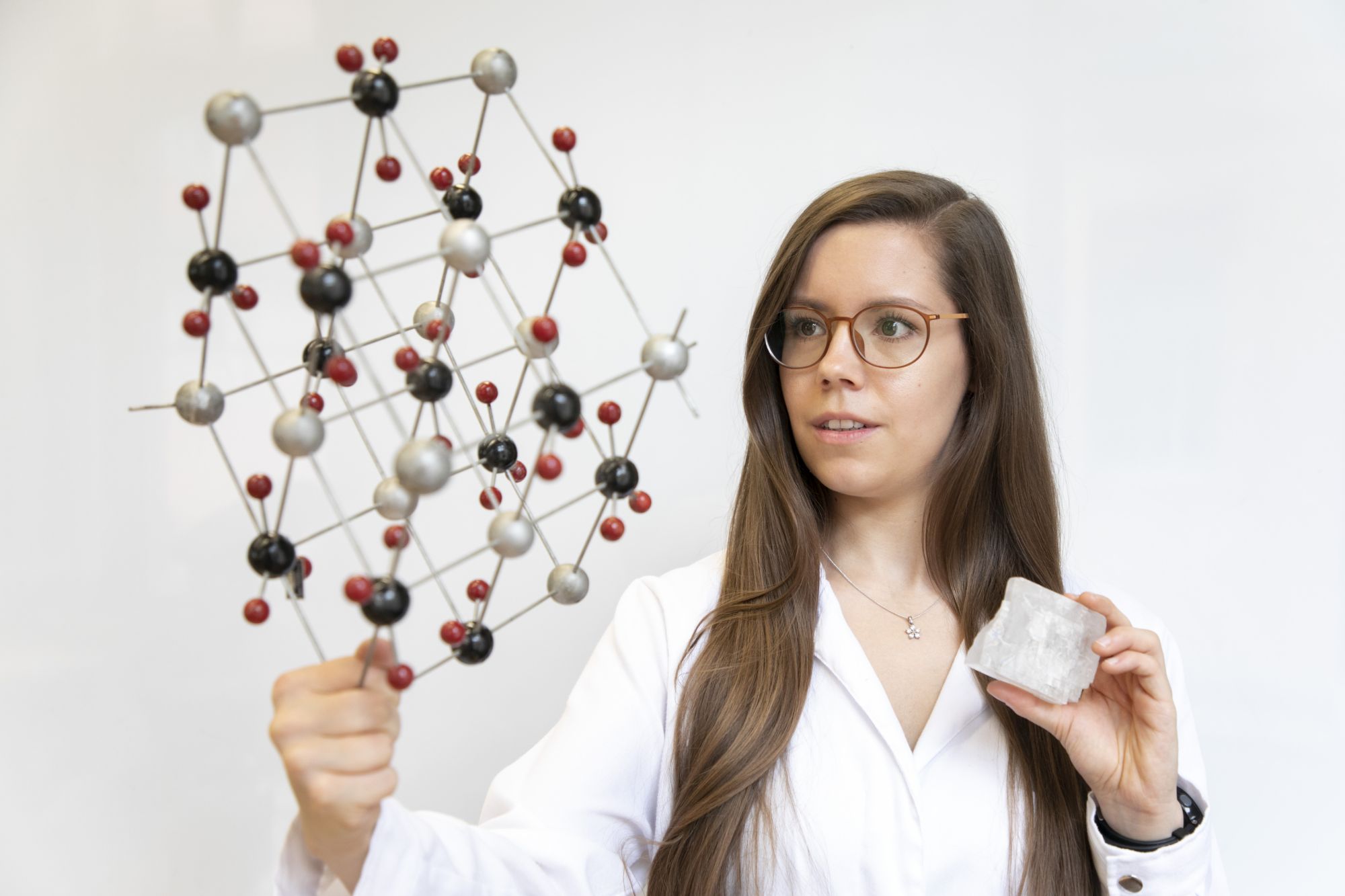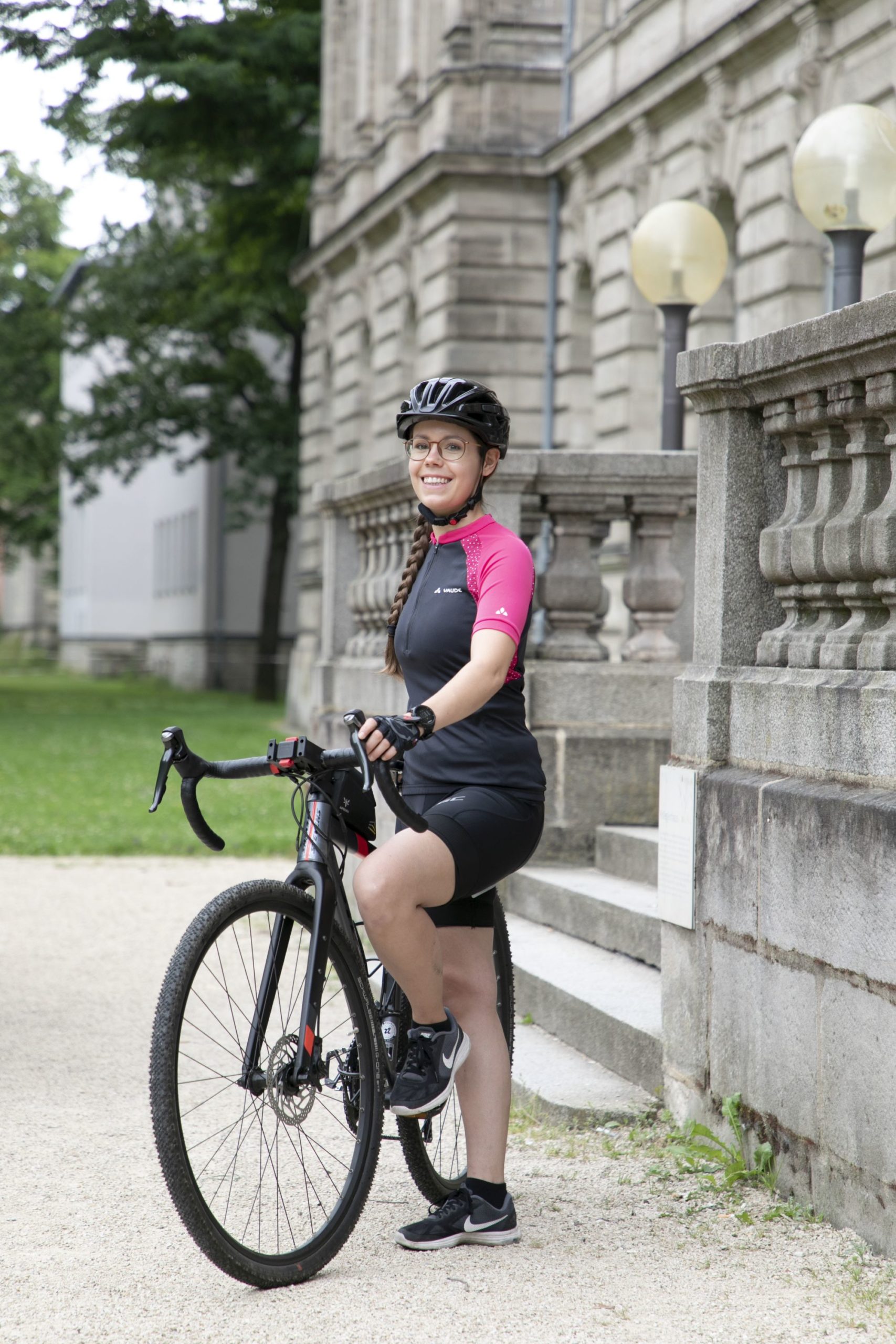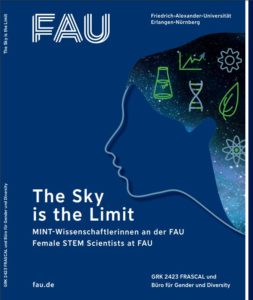Studying minerals in an ideal setting at FAU

Irina Kirchberger, doctoral candidate, probably has one of the most beautiful workplaces at FAU – right in the grounds of Erlangen Schloss. This is where the GeoZentrum Nordbayern is located. Having studied geosciences – where 50% of graduates were female – she is now conducting research into various types of cement within the Mineralogy Research Group. This is important for construction materials and buildings. Whether she will work in the construction industry some day or else stay in academia is a decision she’s leaving until after her doctoral degree. But one thing is already certain: research is close to her heart.
Doctoral candidate Irina Kirchberger: ‚Studying minerals in an ideal setting at FAU’
From volcanoes to a STEM degree
‘Ever since I was a child, I watched lots of TV documentaries on natural and weather phenomena and read books about them. From the eighth grade onwards, I was interested above all in volcanoes. Although I had chosen the social sciences pathway in the eleventh grade at technical college, I really wanted to study geosciences – volcanoes are part of it – in order to learn more about nature and its interconnected processes. But I noticed after three semesters that mineralogy interested me more than petrology, that is, the study of rocks. That’s why I switched courses and did my BSc and MSc in mineralogy.’
My daily life? Field trips!

‘Among others, our everyday life in geosciences encompasses a lot of field trips. We set off together into the terrain and survey rocky outcrops. These are areas on Earth’s surface where rock is exposed. We also practise rock characterization there, meaning that we observe very closely and perceive with all our senses how the rock looks, feels and smells. The aim is to note all this down in a field book to help compile the field trip report later on. We also draw conclusions about how the rock formed and now and again find fossils. However, geosciences also means lab work. This is a key part of all our advanced courses. For example, we have to prove our theories through experiments or more precise observations of materials gathered in the field or produced in the lab.’
Useful research for house construction
‘Since I’ve chosen advanced applied mineralogy and specifically construction chemicals, I’m now conducting research into cements as part of my doctoral degree. Of course, you don’t find these in classic rocky outcrops, so field trips are no longer on my daily agenda. I tend rather to spend more time in the lab mixing small cement samples. These mostly weigh just a few grams. I try to understand which phases occur as the cement hardens and how we can influence these. Cement is an important construction material for industry, but it’s also used as grout in buildings or as tile adhesive. In addition to my practical experiments, I analyse and interpret the data I’ve collected and then write articles for publication. These are in turn part of my doctoral thesis. Since the start of my doctoral degree, I’ve had an assistant who helps me tremendously with my lab work. And as a doctoral candidate I also teach.’
My involvement at FAU:
‘During my studies, I was active in the geosciences student association. I was also deputy spokesperson of the Student Committee as well as student representative on the Faculty Council of the Faculty of Sciences. In addition, I contributed to FAU’s practical engineering course for young people (Jugend-und-Technik-Praktikum), which offers school students from the eighth to the twelfth grade an insight over several days into the wide range of professions to be found in engineering and physics. And during Girls’ Day I worked on experiments together with the girls.’
What I appreciate about FAU:
‘Even as a student, I found the collegiality really fantastic. The student association organises a weekend for new students in Nördlinger Ries – an impact crater – with students in higher semesters, who show them what it means to be a geologist. They really make a lot of effort to bring people together! Apart from that, there’s the Barbara Party for everyone at the GeoZentrum, which is also organised by the student association and traditionally takes place in the E-Werk cultural centre in Erlangen. Lecturers, students and alumni then celebrate Saint Barbara’s Day together. She’s the patron saint of geologists. The convivial atmosphere in this degree programme here at FAU is also reflected 1:1 in my current Applied Mineralogy research group. Most of the people I work with have become friends.’

Don’t let anything get you down!
I was obliged to justify my choice of degree even before I started studying: ‘Why does a girl who went to a grammar school with a focus on languages, who then switched to French at a secondary modern and then earned a social science qualification at technical college want to study a natural science subject?’ was the question asked. Some people around me expressed their concerns and advised me against it. For example, a career adviser told me that with my prior education I wouldn’t manage a geosciences degree anyway. But I by no means let that get me down! The biggest obstacle during my actual studies was in fact the maths exam because I dreaded it and used to think that I didn’t understand more complex mathematics. I also kept reminding myself that I indeed didn’t have any deeper scientific training whatsoever. But I passed the exam!’
Career plans? Industry or academia
‘Since I thoroughly enjoy research, I’d like to continue doing that professionally. Right now, I can’t yet say whether in industry, that is, with a building chemicals company, or in academia. In principle, I’m open to both options. First of all, I’m probably going to be busy with my doctoral degree up until 2024.’
My advice for future STEM women:
‘All I can say to schoolgirls is: Don’t underestimate yourselves – even if you perhaps come from a social sciences pathway attechnical college or didn’t take science in your final examinations at school. If you’re really keen about something, you’ll master most obstacles. With sufficient motivation, you can achieve quite a lot more than you perhaps previously thought! I advise women wanting to earn a doctoral degree in a STEM subject: If you are so passionate about a subject that you’re happy to get to grips with it for another few years, then go for it!’
This article is part of the brochure “The Sky is the Limit”

Brochure “The Sky is the Limit”
Diverse, inspiring and innovative, the brochure “The Sky is the Limit” introduces female researchers in STEM subjects from the Faculty of Engineering and the Faculty of Sciences in a series of varied interviews.
Other interviews are available on the Research website.
Download the brochure “The Sky is the Limit — Female STEM scientists at FAU”
The publication is the result of collaboration between RTG 2423 FRASCAL and the Office of Equality and Diversity. Dr. Susanne Stemmler conducted the interviews.